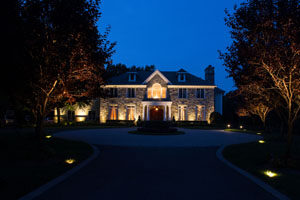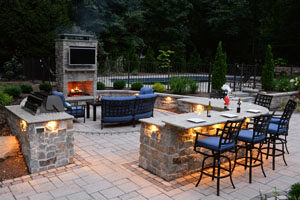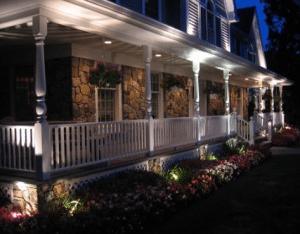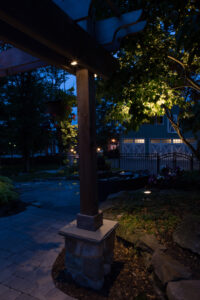 Never underestimate the power of landscape lighting. When the sun goes down and the sky gets dark, you need something outside your home to keep it safe, beautiful inviting and well lit. Unfortunately, some homeowners simply pick up an inexpensive box of low voltage lighting or solar lights at the local retail store, stick them in the yard and never look back. This will hardly do your home justice! With so many different types of low voltage lighting systems and components on the market, it’s not easy to find the perfect lighting system for your home.
Never underestimate the power of landscape lighting. When the sun goes down and the sky gets dark, you need something outside your home to keep it safe, beautiful inviting and well lit. Unfortunately, some homeowners simply pick up an inexpensive box of low voltage lighting or solar lights at the local retail store, stick them in the yard and never look back. This will hardly do your home justice! With so many different types of low voltage lighting systems and components on the market, it’s not easy to find the perfect lighting system for your home.
What are the Benefits of a Landscape Lighting System?
First, let’s discuss the many benefits of having a landscape lighting system installed. By understanding the benefits, you’ll be more willing to take time in choosing your investment.
- Aesthetics
- Curb appeal
- Extends the season
- Extends functional space
- Highlights particular landscape, home or architectural features
- Safety when walking
- Security from intruders
- Increased home value
- Creates safe passageways from one point to the next
What Do You Hope to Achieve?
What are your personal reasons for investing in a lighting system? Do you want to increase your home’s aesthetic properties? Extend the length of time you can enjoy your yard after the sun sets? Create security? Make something in your yard a focal point?
By defining your goals, you can narrow down your search. It’s okay to have multiple purposes for the lights, too. Yards look their best with various layers of light.
 What Arrangement Do You Have in Mind?
What Arrangement Do You Have in Mind?
Where the lights will be installed are dependent on what purpose they have. Some of the most common places for installation include walkways, stairs, decks and patios and trees. Landscape lights are also used to accent certain features in the yard, such as fountains, statues, bushes, trees and building facades. The lights can be pointed downward onto these features to make them appear full and vibrant while casting a soft glow. Or, you may point them upward to highlight features.
The Fixture vs the Light
Too often, people are concerned about the shape and color of the fixture. Although you may want the fixture to complement the exterior of your home, the most important feature to give attention to is the light. Instead of focusing on the shape, size or color of the fixture, notice what effects the light is going to have on you and your guests.
Solar or Low Voltage Lighting?
Outdoor lighting systems are available in solar or low voltage selections. Solar powered lights are inexpensive, easy to install and environmentally friendly. Since they get their power from the sun, they don’t use any electricity. However, solar lighting may not be the best solution depending on the hours of sunlight and interference of shade that may reduce how long the lights can work through the night. Additionally, the light from solar power tends to be dim compared to a traditional system.
Low voltage landscape lights are safe, easy to install and simple to maintain. They are more dependable than solar lights since they do use electricity, but it’s typically low volts of 12. You will need to choose a transformer for low voltage lighting large enough to handle all the fixtures you decide to install as well as some room for future growth. Inevitably people add to the system as they enjoy it so much.
Incandescent, Fluorescent, Halogen or LED Lighting?
Next up – do you prefer incandescent, fluorescent, halogen or LED lights?
- Incandescent is what we are used to seeing. The color is natural to our eyes and sense. It is the standard for the color of the lights as well as the brightness. The downside is that they consume a lot of wattage and require heavy gauge wire and larger transformers to operate.
- Fluorescent lights are very white in color and not as popular as other types.
- Halogen landscape lights are traditional lights that are fairly inexpensive but use up a lot of electricity.
- LED lights are more expensive on the front end, but they use far less electricity and have a longer lifespan. This means lower energy bills and consumption as well as less maintenance from having to switch out the bulbs. One fear people have is that LED bulbs are too white. That said, the color is able to be made in warmer colors so it is more like a traditional lamp. In fact they come in several different Kelvin temperatures
Here is a great chart to help see that.
LED bulbs used to be in the 4000-6000 range. Today they are in the 2700-5000 range.
Where Can I Get the Best Lighting System?
The cost of store bought systems is low because they use low wattage bulbs requiring lighter gauge wire and smaller transformers. Yes – you can get a lot of fixtures for a little bit of money, but you are buying lower wattage light bulbs, lighter gauge wire and smaller wattage transformers. None of that will compare to a professional system. Good light bulbs require proper electricity and transformers, all of which cost more than your typical store bought components.
Sure, you can get a decent system at the retail store, but if you want your landscape to come to life at night. you need to put some effort, components and money into it along with some good old fashioned experience.
That’s where Horizon comes into the picture.
Try Before You Buy
No matter how hard you may plan for a landscape lighting system, the fact is that some people are disappointed when they have the system installed. Maybe the lights cannot illuminate the space, or perhaps some lights should be illuminating upward when their beam is spreading out. Wouldn’t it be nice to actually try a system before you buy it?
At Horizon Landscape, we allow our clients to try before they buy. We’ll work with you to determine the best fit for your home based on the above factors. Then, we can bring a demonstration lighting kit to your home and test it out before you commit to buying it. This way, you’ll be able to make sure that the lights look awesome in your yard and give it the justice it deserves before they are installed.
Things we look for are:
- Beams that are bright and narrow when they need to be softer and spread out.
- Lights that do not have the wattage to properly illuminate the subject matter.
- Too few light fixtures to properly illuminate the area.
- Too many fixtures so there is no darkness between lights to make an impact.
- Improper wire sizing to carry the voltage.
- Transformers that are too small for the number of lights on the system.
For a great selection of landscaping lights and the option to try before you buy, shop with Horizon Landscape. Call us today to at 201-848-0022 to speak with a member of our team!


